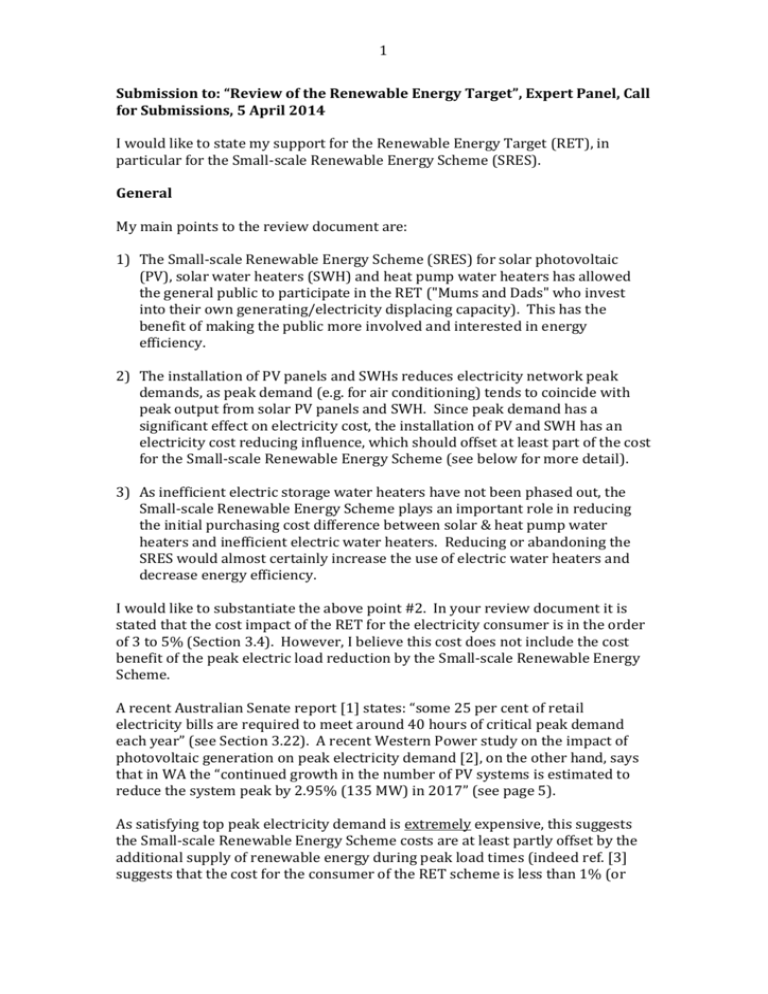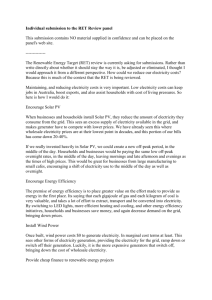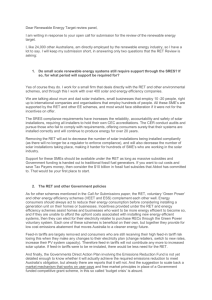Submission to: “Review of the Renewable Energy Target”, Expert
advertisement

1 Submission to: “Review of the Renewable Energy Target”, Expert Panel, Call for Submissions, 5 April 2014 I would like to state my support for the Renewable Energy Target (RET), in particular for the Small-scale Renewable Energy Scheme (SRES). General My main points to the review document are: 1) The Small-scale Renewable Energy Scheme (SRES) for solar photovoltaic (PV), solar water heaters (SWH) and heat pump water heaters has allowed the general public to participate in the RET ("Mums and Dads" who invest into their own generating/electricity displacing capacity). This has the benefit of making the public more involved and interested in energy efficiency. 2) The installation of PV panels and SWHs reduces electricity network peak demands, as peak demand (e.g. for air conditioning) tends to coincide with peak output from solar PV panels and SWH. Since peak demand has a significant effect on electricity cost, the installation of PV and SWH has an electricity cost reducing influence, which should offset at least part of the cost for the Small-scale Renewable Energy Scheme (see below for more detail). 3) As inefficient electric storage water heaters have not been phased out, the Small-scale Renewable Energy Scheme plays an important role in reducing the initial purchasing cost difference between solar & heat pump water heaters and inefficient electric water heaters. Reducing or abandoning the SRES would almost certainly increase the use of electric water heaters and decrease energy efficiency. I would like to substantiate the above point #2. In your review document it is stated that the cost impact of the RET for the electricity consumer is in the order of 3 to 5% (Section 3.4). However, I believe this cost does not include the cost benefit of the peak electric load reduction by the Small-scale Renewable Energy Scheme. A recent Australian Senate report [1] states: “some 25 per cent of retail electricity bills are required to meet around 40 hours of critical peak demand each year” (see Section 3.22). A recent Western Power study on the impact of photovoltaic generation on peak electricity demand [2], on the other hand, says that in WA the “continued growth in the number of PV systems is estimated to reduce the system peak by 2.95% (135 MW) in 2017” (see page 5). As satisfying top peak electricity demand is extremely expensive, this suggests the Small-scale Renewable Energy Scheme costs are at least partly offset by the additional supply of renewable energy during peak load times (indeed ref. [3] suggests that the cost for the consumer of the RET scheme is less than 1% (or 2 $15) per year (see page 18) and the Australian Solar Council even suggests the SRES on its own reduces the electricity cost by 0.8%1 [4]). I believe it is very important that the RET committee includes the cost reduction provided by the additional supply of renewable energy during peak load times by the SRES and considers ref. [5]. Answers to specific questions from the review document How has the RET performed against the objectives in the Renewable Energy (Electricity) Act 2000? In my understanding the objectives of the act are being met. The RET is certainly achieving additional generation and electricity displacement from renewable energy. As a result there is greater use of more environmentally sustainable energy sources and participation of the general population in the RET (see comment #1 above). Are there more efficient and effective approaches to achieving these objectives? I believe the current RET framework is efficient and effective. As I understand it, the RET does not rely on tax payer funding and it encourages private investment into electricity generating capacity and electricity displacement. Do the objectives of the Act remain appropriate, in light of falling electricity demand and the Government’s target and policies for reducing greenhouse gas emissions? I do not understand this question, as it asks if the RET is still appropriate because it is achieving its objective (reducing the electricity demand and greenhouse gas emissions)? How has the RET influenced the development of the renewable energy industry? The RET is increasing the quality and performance of the renewable energy products offered by industry. It also encourages the Australian development of new energy technologies. Do small-scale renewable energy systems still require support through the SRES? If so, for what period will support be required for? Yes, small-scale renewable energy systems still require support. The SRES impact on the electricity costs currently appears to be near cost neutral (see also ref [5]). According to your review document the SRES employs around 17,000 people and enables of the wider Australian population to participate in the scheme. Reducing or discontinuing the SRES would result in a loss of expertise & The -0.8% contribution of the SRES to the residential electricity price increases also appears in the 2011 AEMC report on “Retail electricity price estimates” [5]. 1 3 manufacturing (e.g. solar water heater manufacturers) and a loss in momentum to move to cleaner more efficient energy sources. The SRES appears to be a particularly successful part of the RET and should be allowed to continue as planned (see also point #3 above). Harry Suehrcke 15 May 2014 References [1] The Senate, Select Committee on Electricity Prices, Reducing energy bills and improving efficiency, Section 3.22, November 2012 (see: http://www.aph.gov.au/~/link.aspx?_id=D3162996DBB04099B6835FD018B4C E16&_z=z). [2] Jones, B., Nigel, W. and Lark, A., Western Power, Study on the impact of Photovoltaic (PV) generation on peak demand, page 5, 5 April 2012 (see: http://www.westernpower.com.au/documents/reportspublications/Photovolta ic_Forecast_Public_Version_2012.pdf). [3] Australian Government response to the Senate Select Committee on Electricity Prices report: Reducing energy bills and improving efficiency, page 18, June 2013 (see: http://www.innovation.gov.au/Energy/EnergyMarkets/Pages/ReducingEnergy BillsImprovingEfficiency.aspx). [4] Australian Solar Council, “In 2015/16 household solar will $ave all Australians more than it costs” (see: http://solar.org.au/infographics/save-onbills/). [5] Australian Energy Market Commission (AEMC), Retail electricity price estimates 2010-2011 to 2013-2014, page 2, December 2011 (see: http://www.aemc.gov.au/Media/docs/Information%20sheet-b6ea33d3-73c84e89-b767-d619f3149d3e-1.PDF).







